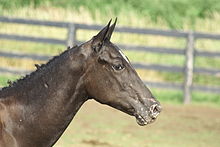- Mottle
-
This Appaloosa horse shows mottling around its mouth and nostrils. In this particular case, it is a normal hereditary trait linked to a spotted coat color pattern and not a sign of disease

Mottle or mottling is the appearance of uneven spots. It is commonly used to describe plants or the skin of animals. In plants, mottling usually consists of yellowish spots on plants, and is usually a sign of disease or malnutrition.[1] Many plant viruses cause mottling, some examples being:
Mottling is sometimes used to describe uneven discolored patches on the skin of humans as a result of cutaneous ischemia (lowered blood flow to the surfaces of the skin) or Herpes zoster infections.[2] In animals, mottling may be a sign of disease, but may also be a hereditary trait, such as seen with the champagne and leopard complex genes in horses.
Mottles can also refer to discoloration in processed food, such as butter.[3]
In geology, mottled refers to a patchy/blotch texture of alteration or interbedding, commonly found in limestone and commonly caused by bioturbation.[4]
Literature
- ^ ICTVdB Management (2006). 00.057.0.01.068. Tobacco vein mottling virus. In: ICTVdB - The Universal Virus Database, version 4. Büchen-Osmond, C. (Ed), Columbia University, New York, USA
- ^ Def. of Anesthesia and IC - www.aic.cuhk.edu.hk/web8/Skin%20mottling.htm
- ^ Hunziker, O F; D. Fay Hosman (March 1, 1920). "Mottles in Butter—Their Causes and Prevention" (PDF). Journal of Dairy Science (American Dairy Science Association) 3 (2): 77–106. doi:10.3168/jds.S0022-0302(20)94253-4. http://jds.fass.org/cgi/reprint/3/2/77. Retrieved 2008-06-28. "Mottles refer to uneven color in butter, causing the appearance in the body of the butter, of deep yellow, translucent blotches interspersed by whitish, opaque dapples."
- ^ http://tin.er.usgs.gov/geology/state/sgmc-unit.php?unit=CTOse%3B0

This plant virus article is a stub. You can help Wikipedia by expanding it.

